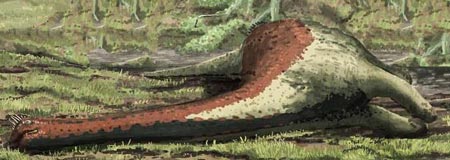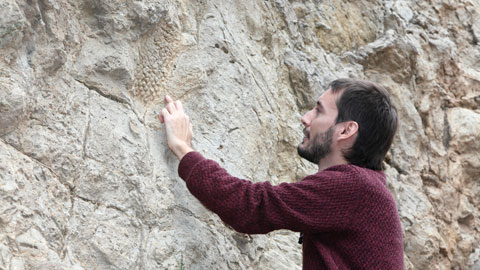Titanosaur Trace Fossils Excite Palaeontologists
Now that team members have published an article on Australia’s newest titanosaurid (Savannasaurus elliottorum), we can turn our attention to another scientific paper, actually published last month, which details an exciting titanosaur related discovery but this time from Europe, or to be more precise Catalonia in Spain. Researchers have discovered fossils of skin impressions in rocks that were formed from sediments deposited at the very end of the Age of Dinosaurs.
A Close View of the Larger of the Two Dinosaur Skin Impression Fossils
Picture credit: Universitat Autònoma de Barcelona (Autonomous University of Barcelona)
How was the Titanosaur Skin Impression Made?
The picture above shows the bigger of the two dinosaur trace fossils. Large, irregular, quite angular scales can be made out.
However, what the photograph shows is not the actual skin impression but a natural cast. Sometime around 66 million years ago a dinosaur was crossing a stretch of mud close to a river. It may have slipped and fallen or perhaps it simply rested for a while lying down on the sticky muddy surface. An impression of the animal’s scales was made in the soft mud. These marks were later covered by sand, perhaps as a result of the river level rising.
Over tens of thousands of years, this sand was slowly turned to sandstone (sedimentary rock). Uplift and subsequent erosion exposed the rock layer where the natural cast was preserved and over time the softer mudstone was gradually eroded away leading to the exposure of the natural cast of the dinosaur’s skin.
Trace fossils such as this preserve a moment in time, they preserve evidence of behaviour or activity. If you look carefully you can see shadows around some of the individual scales, the scales are raised. This sort of trace fossil is known as an epirelief (raised) fossil.
How Do We Know the Fossils Come from a Titanosaur?
In truth, nobody knows for certain what type of animal left these impressions of its skin. The shape of the scales are similar to other dinosaur skin impressions, so it is very likely that these fossils represent a member of the Dinosauria. The size of the individual scales are just too big for the theropod and ornithopod dinosaurs that are known to have lived in this area some sixty-six million years ago.
In addition, palaeontologists have found the big, rounded tracks of wide-bodied titanosaurs in similar-aged strata close by. So, in all probability, these two fossils represent a titanosaur and it is likely that the two epirelief trace fossils, one about twenty centimetres wide and the other just five centimetres across and within one and a half metres of the other, were made by the same animal at the same time.
For models and replicas of titanosaurs and other dinosaurs: CollectA Deluxe Prehistoric Animal Replicas and Models.
Titanosaur Has a Lie Down
Picture credit: Mark Witton (with some background alteration by Everything Dinosaur)
The Last European Dinosaurs
Universitat Autònoma de Barcelona researcher and lead author of the scientific paper published in the “Geological” magazine, Victor Fondevilla, explained that although dinosaur skin impressions have been discovered in Europe before, they don’t come from the very end of the Mesozoic.
He stated:
“This is the only registry of dinosaur skin from this period in all of Europe, and it corresponds to one of the most recent specimens, closer to the extinction event, in all of the world.”
These trace fossils, located in the red sandstone beds of the Tremp Formation (southern Pyrenees), represent some of the most recent dinosaur fossils ever made, coming from the chronozone associated with the period of the Maastrichtian faunal stage immediately before the K-Pg extinction event. These, in situ titanosaur fossils come from C29r chronozone or chron, as these slices of time are sometimes referred to. Thus, they represent some of the last fossils known representing titanosauriforms.
Victor Fondevilla Points out Where the Larger of the Two Trace Fossils can be found on the Exposed Rock Face
Picture credit: Universitat Autònoma de Barcelona (Autonomous University of Barcelona)
The Scientific paper: “Skin Impressions of the Last European Dinosaurs” published in Geological Magazine (Cambridge University Press).
Visit Everything Dinosaur’s website: Everything Dinosaur.
To read our article on “Wade” Savannasaurus elliottorum: Titanosaurs Crossing Continents.









Leave A Comment